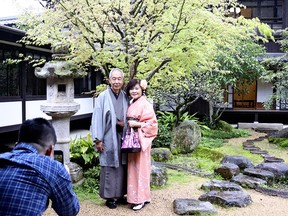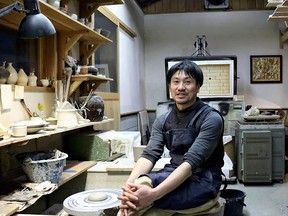Reviews and recommendations are unbiased and products are independently selected. Postmedia may earn an affiliate commission from purchases made through links on this page.
Travel
Yamaguchi, ‘Kyoto of West,’ preparing to accept more tourists

The city was selected as one of The New York Times’ 52 Places to Go in 2024
Article content
The municipal government of Yamaguchi is gearing up to accommodate more international visitors after the city was selected as one of The New York Times’ 52 Places to Go in 2024. Expectations are high, but concerns are also popping up.
In early April, about 20 tourists from Taiwan visited Saikotei, a traditional Japanese building founded in 1877. It is a tourist facility in Yamaguchi which was previously a luxurious restaurant.
Advertisement 2
Article content
A 32-year-old woman visiting the location was helped into a kimono and had her picture taken in the garden. “Yamaguchi is quiet and has a beautiful natural environment. I really like it,” she said with a smile.
The city is known for its many tourist attractions, including a five-story pagoda in Rurikoji temple and the Yuda Onsen hot spring resort. But the article in The New York Times also introduced such little-known spots as pottery kilns and coffee shops local people have been fond of for many years.
Among them is Mizunoue Kiln, a pottery gallery-cum-atelier located on the grounds of Toshunji temple. Craig Mod, the writer who recommended Yamaguchi in the newspaper as the “Kyoto of the West,” visited the kiln more than two years before, according to Gakuji Masui, the potter who runs the kiln. He said he was initially surprised that Yamaguchi was featured in the newspaper.

“Considering his perspective on travel, I understood why,” Masui said. The American writer values places where a traveler can get a sense of the daily lives of people living there, he said.
The kiln began accepting foreign tourists. Some tourists from Germany and Canada said that they had decided on their destination after reading the article. Masui responded to them using a translation app, saying that he is happy to be able to have this new experience.
Article content
Advertisement 3
Article content
Responding in foreign languages
Publicity in a leading U.S. newspaper can offer a great opportunity for the local community to draw international visitors to Japan.
The Yamaguchi municipal government sent two officials to Morioka, which was selected among the “52 Places to Go” in 2023, to collect information on what kind of response the city had.
According to the Iwate prefectural government, 24,352 foreign tourists (preliminary figures) visited Morioka in the first half of 2023 alone, four times the number of tourists in the previous year. The Yamaguchi city government, which received about 9,200 foreign visitors in 2022, also expects a significant increase.

This fiscal year, the city government has increased the number of staff who can speak foreign languages. It is also subsidizing the cost of making multilingual menus at restaurants and other shops. It will expand the free Wi-Fi service at tourist information centers for foreigners who are using the map and translation functions on their smartphones.
Private sector entities have also begun to increase accommodations for foreign visitors. At JR Yamaguchi Station, coin-operated lockers run by a store at the station were removed at the end of last September when the store was closed. But Chugoku JR Bus Co. reinstalled them in March this year.
Advertisement 4
Article content
Nishi No Miyabi Tokiwa, a long-established inn in the Yuda Onsen hot spring resort, carried out customer-service training in English for all of its employees.
Overtourism concerns
On the other hand, concerns about the negative effects of increased numbers of international visitors to the city have been growing in the local community.
According to a local taxi association, there has been a shortage of cabs, as it cannot secure enough taxi drivers after having reduced their numbers during the COVID-19 pandemic. Depending on the timing, some tourists may be forced to wait a long time to get a cab, the association said.

“If a large number of foreigners suddenly arrive, I don’t think we would be able to accommodate all of them,” said a woman who owns a restaurant in the Yuda Onsen district. Besides her concern over the language barrier, her restaurant only accepts cash payments. She added, “I also don’t want our regular customers to be unable to get a seat.”
Since many tourist spots in the city are close to residential areas, there are also concerns about noise and litter that may accompany a large increase in the number of tourists. “We would like to improve the hospitality environment while listening to the voices of our citizens to protect their daily lives,” said an official at the municipal government.
Advertisement 5
Article content
Researchers predict 9 billion yen in benefits
The economic effect of Yamaguchi being featured in The New York Times could mean an influx of 9 billion yen this year, according to an estimate by Yamaguchi University. The estimate was made by a research team led by Associate Professor Shinya Kato at the Faculty of Economics and was announced on May 2.
It was based on data from Morioka and other cities abroad that were featured as must-visit places in the past. The research team also used a survey that asked visitors to Rurikoji temple’s five-story pagoda how much they would spend during their visit to the city.
The estimate says that the number of holidaymakers visiting the city will increase by 912,000, of which 55,000 will be foreign visitors.
Article content


)






